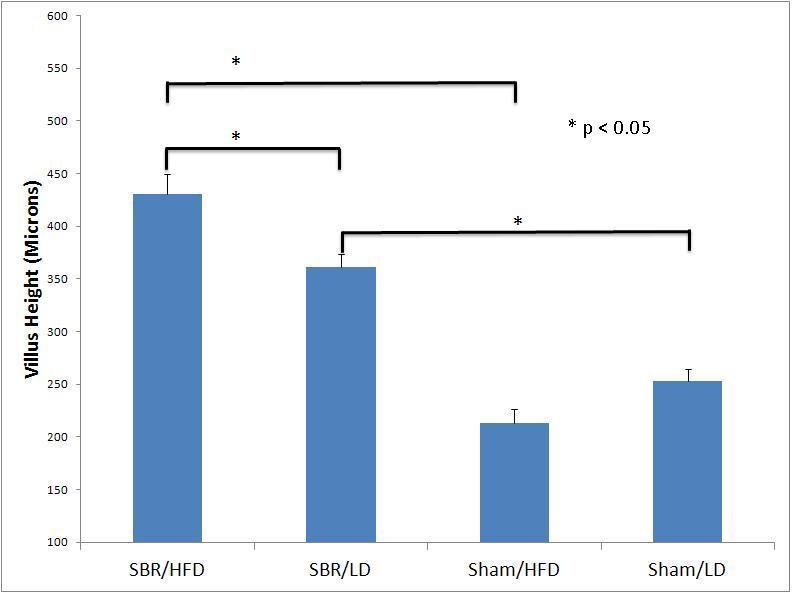|
Back to Annual Meeting Program
High Fat Diet Enhances Villus Growth During Adaptation After Massive Small Bowel Resection
Pamela M. Choi*, Raphael C. Sun, Jun Guo, Christopher R. Erwin, Brad Warner
Department of Pediatric Surgery, Washington University, St Louis, MO
Background: Adaptation is a compensatory process following small bowel resection (SBR) that results in villus growth and enhanced mucosal surface area. In prior studies, High Fat Diet (HFD) had been shown to enhance adaptation responses if fed immediately following SBR. The purpose of this study was to determine if HFD could further enhance villus growth after resection-induced adaptation had already taken place.
Methods: C57/Bl6 mice, aged 6-8 weeks, underwent a 50% proximal SBR or sham operation (bowel transection with reanastomosis alone) and then provided a standard rodent liquid diet (LD) ad lib. After a typical period of adaptation (7 days), SBR and sham-operated mice were randomized to receive either LD or HFD (42% kcal/fat) for an additional 7 days. Mice were individual caged, and food intake and feces output were measured daily. Mice were then harvested, and small intestine was collected for analysis.
Results: There were no differences in caloric intake or stool output between any of the groups. However, Sham mice had increased weight gain compared to SBR mice independent of diet. As shown in Figure 1, adaptation occurred in both SBR groups, however the SBR/HFD had significantly increased villus height compared to SBR/LD. When compared to their sham counterparts, there was a 102.3% increase in villus height in the HFD group compared to only 42.6% in the LD group. Real-Time PCR was performed from mRNA of isolated intestinal villus cells, and CD36 expression was markedly elevated after high fat diet (greater than 50-fold) in the SBR/HFD group compared with SBR/LD mice.
Conclusion: While a week-long exposure to increased enteral fat alone did not affect villus morphology in sham-operated mice, HFD significantly increased villus growth in the setting of resection-induced adaptation. These data support the clinical utility of enteral fat in augmenting adaptation responses in patients who have been subjected to massive SBR. Increased expression of CD36 suggests a possible mechanistic role in dietary fat metabolism and villus growth in the setting of short gut syndrome.

Figure 1: Villus Height Measurements after SBR or Sham Operations
Back to Annual Meeting Program
|


